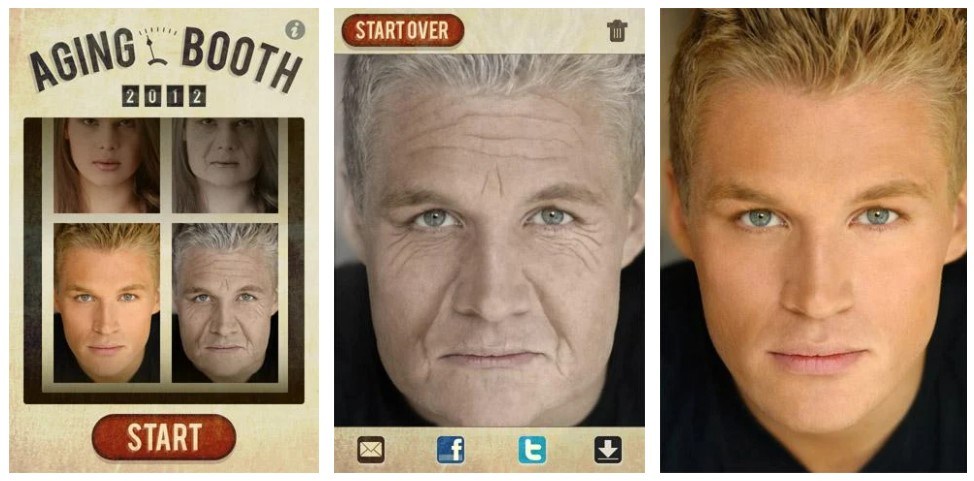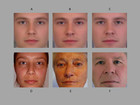
Also, these methods require a lot of human interference. Maximum of the conventional wrinkles examination schemes is semi-automatic.
#Face morph age progression applications skin
In any medical cosmetology, skin analysis becomes an important procedure for the wrinkle detection or any other medical problems. The primary focus of this research work is to study the appearance of face wrinkles, which is considered as one of the most noticeable changes that happen as people become older. The results showed that automating the process can effectively detect the malaria parasite in blood samples with an accuracy of over 94% with less complexity than the previous approaches found in the literature.Īging is a natural process that affects the human body. Extensive performance analysis is presented in terms of precision, recall, f-1score, accuracy, and computational time. Then Decision Tree, Support Vector Machine, Naïve Bayes, and K-Nearest Neighbour classifiers were trained using these six features. Six different features-VGG16, VGG19, ResNet50, ResNet101, DenseNet121, and DenseNet201 models-were extracted. For this reason, this study proposes the use of machine-learning models to detect the malaria parasite in blood-smear images. Due to the high number of cases and lack of sufficient diagnostic facilities and experienced medical personnel, there is a need for advanced diagnostic procedures to complement existing methods.

Malaria is one of the most infectious diseases in the world, particularly in developing continents such as Africa and Asia. The paper focuses on the various practical applications of super-resolution face aging using Generative Adversarial Networks (GANs). The proposed work is evaluated with quantitative and qualitative methods, produces synthesized face aged images with a 0.001% error rate, and is also evaluated with the comparison to prior methods. Moreover, the experimental results are obtained from five publicly available datasets: UTKFace, CACD, FGNET, IMDB-WIKI, and CelebA. Thus, presents more detailed information in an image because of its high quality. Then image sharpening with edge enhancement is done to give high-quality input to SRGAN, which further generates the super-resolution face aged images. Further, the regex filtering process is performed to separates the synthesized face images from the output of AttentionGAN. Then attention mask is multiplied with the corresponding content mask along with an input image to finally achieve the desired results. One subnet for generating multiple attention masks and the other for generating multiple content masks. AttentionGAN uses two separate subnets in a generator. So, to solve the issue, the proposed work focuses on the realistic face aging method using AttentionGAN and SRGAN. Research has been continuing in face aging to handle the challenge to generate aged faces accurately. The existing face age progression approaches have the key problem of unnatural modifications of facial attributes due to insufficient prior knowledge of input images and nearly visual artifacts in the generated output. In today’s world that demands more security and a touchless unique identification system, face aging attains tremendous attention. Our experimental results do suggest that the proposed approach achieves accuracy, efficiency and possess flexibility when it comes to facial age progression or regression.įace age progression, goals to alter the individual’s face from a given face image to predict the future appearance of that image. We have utilised two datasets, namely the FEI and the Morph II, to test, verify and validate our approach. To do this, we have utilised a pre-trained convolutional neural network based on the VGG-face model for feature extraction, and we then use well-known classifiers to compare the features.

To validate our approach, we compute the similarity between aged images and the corresponding ground truth via face recognition. The resulting image is controlled by two parameters corresponding to the texture and the shape of the face. Thus, given a face image, the target aged image for that face is generated by applying it to the relevant template face image. We use template faces based on the formulation of an average face of a given ethnicity and for a given age. In this paper, we propose a novel approach to try and address this problem.

Over the past decade or so, researchers have been working on developing face processing mechanisms to tackle the challenge of generating realistic aged faces for applications related to smart systems. As such, automatic aged or de-aged face generation has become an important subject of study in recent times. Techniques for facial age progression and regression have many applications and a myriad of challenges.


 0 kommentar(er)
0 kommentar(er)
